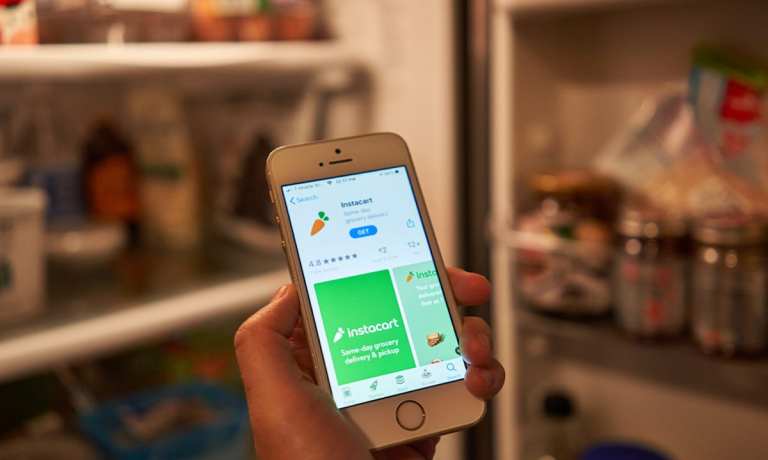
While digital grocery shopping isn’t an entirely new phenomenon, it’s undeniable that the pandemic period has accelerated its progress in ways that would have been nearly unimaginable even eight months ago. Grocery has truly become a multichannel shopping journey this year, as consumers have shifted to using several different purchasing channels to buy groceries.
The physical stores still lead, but as the latest PYMNTS latest Omnichannel Grocery Report demonstrates, a growing majority of consumers buy at least some of their groceries online. According to the survey data, 79.6 percent of all U.S. consumers who buy groceries report purchasing them in-store, but 63.9 percent make at least one of their routine grocery purchases online.
Grocery, it seems, is going a bit more digital by the day. What do the details of that look like?
Non-Food Items Are Digitizing Faster
According to the data, consumers’ willingness to buy online is heavily influenced by what exactly they are buying. Our research shows that 36.6 percent of respondents buy items like cleaning products online, and 28.4 percent do the same with pharmacy products.
Perishable goods seem to be where there is a bit more unwillingness, as only 16.9 percent and 18.7 percent of consumers purchase fresh fruits and vegetables and meat online.
The data also show that 21.1 percent of all consumers who buy non-food grocery items such as shampoo, first-aid items and cleaning products do so online, while 14.3 percent who buy packaged food products also do so online. This strongly suggests that consumers enjoy the experience of buying groceries online, save for those products that they feel they need to inspect in-person before buying, like produce or meat.
Contactless Payments Are In Higher Demand Than They Are In Use
Insofar as consumers are still shopping in stores, the latest study demonstrated increased levels of interest in using touchless payment options at brick-and-mortar shops. That includes things like contactless credit and debit cards, digital wallets, cards on file or other digital methods.
According to the report, 43.1 percent of consumers are interested in contactless credit, 38.9 percent favored contactless debit, 30.2 liked digital wallets, 24.9 percent reported interest in card on file and 17.9 percent expressed interest in using QR codes.
But when it comes to actual usage of contactless payments as opposed to mere interest in it, far fewer consumers are actually using these methods. That suggests an untapped demand for them.
For instance, the research shows that 16.5 percent fewer consumers use contactless credit cards than would like to, while 15.1 percent fewer use contactless debit cards than would like to. There’s also an 8 percent and an 8.8 percent gap, respectively, between the usage and demand for digital wallets and cards on file.
Consumers Take Touchless Options Very Seriously
Though consumers’ usage of touchless payments lags behind consumers’ desire for them, the data indicate that the gap isn’t a sign that consumers don’t take the availability of touchless payment options seriously. In fact, figures indicate that going forward, touchless payments are increasingly a factor in consumers deciding where to shop at all.
According to the study, 35.3 percent of consumers would be willing to leave their favorite grocers for other players that will allow them to pay in-store in a touchless manner. And among those who have already used contactless payments, that increases to 40.6 percent.
Moreover, the draw of touchless payments is strongest with high- and middle-income consumers – 36.9 percent and 36.8 percent say so, respectively. Only 32.1 percent of low-income consumers say the same.
That income differential indicates that the consumers who are most likely to switch grocers for touchless payment options also tend to be those with the greatest spending power – thus the most desirable to retailers.
Walmart Has Won Consumer Favor (Along With Their Grocery Spend)
Consumers are doing most of the grocery shopping these days at the large national chains in general, and Walmart in particular. In fact, PYMNTS’ study found that 67 percent of all consumers buy at least some of their groceries at Walmart.
But more than just shopping at Walmart, the study indicates that people really like the Walmart shopping experience, with 27.8 percent reporting Walmart as their favorite grocer.
That makes Walmart something of a standout among national brands. Many consumers report shopping at national chains like Costco (26.3 percent), Target (32.5 percent) and Sam’s Club (21.7 percent). But shoppers don’t list any of the above as their favorite chains nearly as often as they do Walmart.
Home Delivery Leads As Consumers’ Favorite Way To Receive Groceries Purchased Online
As consumers are encountering more options for digital shopping, they’re developing preferences about how they actually get items once they’ve bought them.
Ordering online and having the goods delivered to their doors continues to lead the pack. Some 22.7 percent of grocery shoppers report ordering groceries online to be delivered at home more now than they did before the pandemic. But that lead is pretty narrow, as 21 percent report doing curbside pick-up of digital orders more now than they did in a pre-pandemic world.
However, trailing both pretty notably is buy online pick up in store (BOPIS), which 11.9 percent are doing more often now than they did before. That stands to reason. If consumers are ordering groceries online during the pandemic to avoid having to set foot in stores or other places where they fear COVID-19 exposure, picking up their groceries in physical stores should lose a lot of appeal.
What The Industry Has Learned
So, what is the lesson for 2021 that grocers of all sizes can take from 2020?
Answer: Consumers have gone digital – if not for all of their grocery buys, then at least for a significant enough share that it looks like the old normal is never coming back, even when the pandemic is over. That means grocers who want to stay competitive in the new year had better be thinking digital and touchless for their consumer relationships going forward.